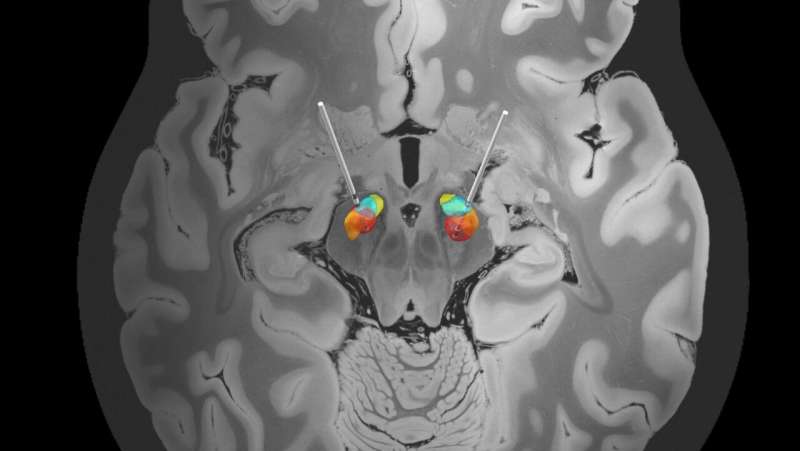Researchers stimulate improvements in Parkinson's treatment

New research led by QIMR Berghofer Medical Research Institute has identified ways to make the most widely-used advanced treatment for Parkinson's disease—deep brain stimulation therapy—more effective and safer.
Deep brain stimulation (DBS) involves implanting electrodes within the brain, which allows the delivery of focused electrical currents to a small target region. The neurosurgical procedure has been shown to reverse some motor-related symptoms of Parkinson's disease, including tremor, stiffness and slowness, with some patients even able to stop medication.
QIMR Berghofer lead researcher and St Andrews War Memorial Hospital neuropsychiatrist Dr. Philip Mosley said the procedure was being used more frequently for the treatment of Parkinson's disease because it reduces disability and improves quality of life for several years, but it can also have harmful side-effects.
"Some patients develop new problems with controlling their impulses and behaving recklessly after this procedure, which can give rise to personal problems and increase the strain on their families," Dr. Mosley said.
"These impulse-control and behavioral problems limit the improvement in quality of life enjoyed by the majority of patients who undergo this procedure. We wanted to find out if there was a subtle difference in the way stimulation was affecting the brains of those people who developed these psychiatric side-effects, and if by exploring these differences we might be able to work out how to stop it happening altogether. We identified that when DBS affected certain parts of the brain, it was linked to impulsivity and harmful behavior."
The deep brain stimulation team at St Andrew's War Memorial Hospital is led by Professor Peter Silburn and Associate Professor Terry Coyne and operates one of the largest DBS centers worldwide, having completed more than 1,000 procedures.
Dr. Mosley recruited 55 recent patients into the study and used an advanced method of brain imaging, called diffusion MRI, to reconstruct the connections between nerve cells in the brain that were stimulated by the implanted electrodes.
"We used a 'virtual casino' that we had previously developed, which simulated 'real-world' impulsivity, and looked at how the brain networks influenced by DBS affected gambling." said Dr. Mosley. "Our participants played the casino before DBS and again once their stimulator was implanted and turned on, so we could quantify whether stimulation influenced them to bet in a more risky manner."
Dr. Mosley found that when stimulation affected the frontal portion of the brain (the prefrontal cortex), participants were more likely to place higher, more risky bets after DBS.
"This region of the brain is important for planning behavior and inhibiting inappropriate actions, so it makes sense that stimulation of this part of the brain can change behavior in this way," he said.
Dr. Mosley also followed the clinical progress of all participants in the study and found that those patients who went on to develop clinically-significant, harmful changes in behavior after DBS had a strong connection between the site of stimulation and a specific region of the prefrontal cortex called the orbitofrontal cortex.
"This was a fascinating finding, because this region has been shown to be important in how the brain evaluates a desired goal and compares it to an actual outcome, in order to work out if behavior should be modified," he said. "It is possible that these individuals developed such significant problems because their brains weren't able to perform this function, which meant that they didn't link poor choices to negative outcomes, and therefore didn't learn from the experience."
"Overall, DBS for Parkinson's disease is usually a wonderful and life-changing treatment. Now, our understanding of how behavior can be linked to the pattern of connections in the brain stimulated by DBS means that we can make this therapy even safer and more effective.
"Specifically, knowing which connections are harmful or helpful will assist neurologists and neurosurgeons decide where best to place the DBS electrodes and how to adjust the device postoperatively so that only regions of the brain responsible for treating the motor symptoms of Parkinson's disease are stimulated."
The study findings have been published in the journal Brain.
The research builds on a previous study led by Dr. Mosley that identified the effects of dopamine replacement medication on the brain network connections of Parkinson's patients who had developed harmful behaviors after commencing drug treatment. Dr. Mosley received the Early Career Psychiatrist Award from the Royal Australian and New Zealand College of Psychiatrists for this work.
More information: Philip E Mosley et al. The structural connectivity of subthalamic deep brain stimulation correlates with impulsivity in Parkinson's, Brain (2020). DOI: 10.1093/brain/awaa148
















